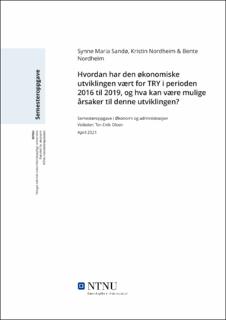| dc.contributor.advisor | Olsen, Tor-Eirik | |
| dc.contributor.author | Sandø, Synne Maria | |
| dc.contributor.author | Nordheim, Kristin | |
| dc.contributor.author | Nordheim, Bente | |
| dc.date.accessioned | 2021-09-14T17:18:44Z | |
| dc.date.available | 2021-09-14T17:18:44Z | |
| dc.date.issued | 2021 | |
| dc.identifier | no.ntnu:inspera:80218484:80446650 | |
| dc.identifier.uri | https://hdl.handle.net/11250/2777260 | |
| dc.description.abstract | I denne semesteroppgaven har vi sett på den økonomiske utviklingen i TRY Reklame i
perioden 2016-2019. Samtidig har vi prøvd å finne årsaker til denne utviklingen. I første del
av oppgaven introduserer vi bedriften og presenterer problemstillingen. Deretter tar vi for oss
teorien oppgaven har basis i. Det vil her bli gjort rede for relevant informasjon knyttet til
regnskapsanalysen og den strategiske analysen vi vil benytte senere i oppgaven. Videre vil vi
belyse hvordan vi har gått frem for å svare på problemstillingen i en egen metodedel. Selve
analysen av TRY Reklame blir presentert i kapittel 5.0. Vi har delt analysen i tre deler:
horisontal analyse, nøkkelstallanalyse og strategisk analyse. Oppgaven avslutter med en
diskusjon av funnene vi har gjort.
I den horisontale- og nøkkelstallsanalysen har vi tatt utgangspunkt i regnskapet deres fra
Proff.no. For ytterligere informasjon og forklaring har vi vært i dialog med TRY Reklames
CFO, Morten Polmar. Vi har hatt hovedfokus på nøkkeltallsanalysen, hvor vi har fokusert på
nøkkeltall knyttet til finansiering, soliditet, likviditet og lønnsomhet. Ut i fra dette ser vi at
selskapet har hatt en negativ økonomisk utvikling i perioden. Likevel overstiger de fleste
tallene normtallene, og vi kan dermed konkludere med at de er i en god økonomisk situasjon.
For å få et mer helhetlig bilde av utviklingen til TRY Reklame har vi foretatt en strategisk
analyse av bedriften. Her har vi tatt utgangspunkt i SWOT, SVIMA og Porters five forces.
For å gjennomføre analysen har vi vært i direkte kontakt med konsulent Trond Sandø. Den
strategiske analysen har vi brukt til å prøve å finne mulige årsaker til den negative
økonomiske utviklingen. Vi ser av Statistisk Sentralbyrå at det er en jevn nedgang i andel TV-seere i Norge. Dette tyder på at fremtidsbildet vil være preget av mindre reklame på de
tradisjonelle mediene. Dette gir utslag på den økonomiske utviklingen til TRY Reklame, da
de kun setter søkelys på tradisjonelle reklameplattformer. Likevel indikerer SWOT-analysen
at TRY Reklame har lagt en god strategi for å imøtekomme utfordringene i tiden som
kommer.
Avslutningsvis, under diskusjon og konklusjon, trekker vi ut hovedfunnene fra
regnskapsanalysen og den strategiske analysen og ser det under ett. Regnskapsanalysen viser
jevnt over en noe negativ utvikling for flertallet av nøkkeltallene. Gjennom den strategiske
analysen ser vi at dette skyldes en nedgående bruk av tradisjonelle reklameplattformer. Til
tross for periodens negative utvikling, ser vi likevel at de overordnet fortsatt har en god iii
lønnsomhet, og utmerker seg som landets største reklamebyrå målt i omsetning (Wikipedia,
2021). Vi har derfor stor tro på TRY Reklame, og gleder oss til å følge med på fortsettelsen. | |
| dc.description.abstract | This thesis conducts a study of the economic development in Norway’s largest advertisement
agency, TRY, in the period of 2016 to- 2019. Simultaneously, we have tried to find the causes
behind this development. First the company and the thesis statement are introduced. Further
on, we present theory related to this topic linked to accounting analyses, followed by a
strategic analysis. This is followed by our research methodology section, which explain our
choices and procedure during this thesis. The analysis of TRY itself will be presented in
chapter 5.0. The analysis consists of three parts; horizontal-, accounting- and strategic
analysis. Lastly, the thesis are discussed.
We gathered data from their financial statements at Proff.no to gain an understanding of the
company’s economic situation. Furthermore, we used this information to calculate different
key indicators to conduct our horizontal- and accounting analysis. In addition, we have been
in contact with the CFO in TRY, Morten Polmar, to get further information and explanation.
Our research and results indicated that the company have had a negative economic
development in the defined period. Nevertheless, the profitability was still satisfying, and we
could therefore conclude that the company is in a decent economic situation.
A strategic analysis of the company was then conducted to get an overall picture of their
development during the defined period. By using strategic tools such as SWOT, SVIMA and
Porters five forces, we got a better understanding of the causes behind their economic
development. To gather comprehensive information about the company and the marked, we
were in contact with one of TRY’s advisor, Trond Sandoe. In addition, we compared this data
to the numbers presented by “Statistisk Sentralbyrå”. The results showed a decrease in the
proportion of TV-viewers in Norway. There is no doubt that this has affected the economic
situation of commercial companies, since a majority still use TV as their main platform.
At last, we present our findings from the accounting- and strategic analysis. Throughout the
strategic analysis our results shows that the negative development is linked to the reduced use
of traditional media platforms. However, our calculated key indicators shows that the
company still has a decent profitability and is by far Norway’s largest commercial company
measured in turnover (Wikipedia, 2021). | |
| dc.language | nob | |
| dc.publisher | NTNU | |
| dc.title | Hvordan har den økonomiske utviklingen vært for TRY i perioden 2016 til 2019, og hva kan være mulige årsaker til denne utviklingen? | |
| dc.type | Bachelor thesis | |
